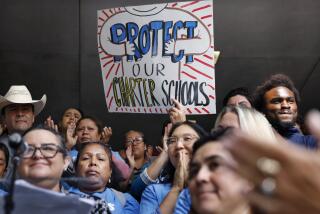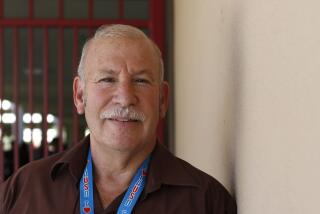L.A. Unified gets a chance to clone good schools, but what are the necessary ingredients?
The concept sounds simple: take a good school, figure out what’s happening to make students successful, and re-create those elements to spread the success somewhere else.
Replication, as this process is called, has become a buzzword with charter schools nationwide as they expand their networks on the promise of bringing high achievement at existing schools to new ones.
Could the idea work for public schools? The Los Angeles Unified School District has a chance to find out.
In April, the district received two $750,000 grants to give such school cloning a try. The school board voted last week to approve the projects.
The grants are controversial because they come from Great Public Schools Now, a relatively new nonprofit that’s closely associated with a push to rapidly expand the number of L.A. charter schools. The group has made a point so far of pledging money to expand good L.A. Unified programs, though some critics contend that these are token gestures to public schools while charter growth remains the group’s real aim.
The district will use the grant money to help open a new magnet school that’s based on King/Drew Medical Magnet High School of Medicine and Science in Willowbrook, and a themed traditional school modeled after Public Service Community High School in Florence-Firestone.
So what are the crucial elements of a school that need to be replicated? At the board meeting, the key features of one of the projects prompted some debate.
Is it the freedom?
Public Service Community High is a pilot school, which means that teachers have a greater say in school governance than they would at a traditional school — and though teachers are unionized, pilot schools have greater flexibility in budgeting, scheduling and hiring.
But the school to be created in its image with help from the grant money — on the site of Charles Drew Middle School in Florence-Firestone — will be a traditional school with a public service theme.
At last week’s school board meeting, new board member Kelly Gonez said it was worth examining whether the features particular to pilot schools are important to Public Service Community High’s success.
“If we’re replicating what has worked … but we’re not doing that in the form of a pilot school, well, how does that work in practice?” Gonez said in an interview. “How do we make sure we still have that culture of … buy-in among teachers?”
Nick Melvoin, her fellow new board member, expressed similar concerns at the meeting.
He said he hoped “we’re really being thoughtful about what it is in each school that works.”
Both Gonez and Melvoin ended up voting in favor of the projects. The two are part of the board’s new charter-backed majority and won their seats with the help of major campaign funding from supporters of charter schools.
Most L.A. charter schools are not unionized, which makes firing teachers easier.
“Antiquated rules” about teacher hiring and firing “can limit the ability of a school to innovate,” Melvoin said in an interview.
“The pilot model … is teacher-driven but has some more flexibilities about how teachers and principals can work together. .. I would be interested in seeing more of that in the district,” he said.
Is it the theme?
District officials, meanwhile, have identified qualities to replicate outside a pilot school’s freedoms. The district’s report to the board mentioned Public Service Community High’s emphasis on writing and positive behavior as well as frequent evaluations to better attune teaching to students’ needs.
The school, which served around 540 students last year and is 96% Latino, performed much better than the district average in state English standardized testing, but worse in math, in which only 13% of students in 2016 met state standards. The class of 2016 achieved an 86.7% graduation rate, higher than the district’s 77% rate.
The new campus, which will open in the 2018-19 school year, will keep students on track with its public service theme, internship opportunities and community college partnerships, said Christopher Downing, superintendent of L.A. Unified’s Local District South. Students will be able to intern at the Los Angeles Department of Water and Power and other workplaces, learn about advocacy through community service and attend classes with a public service focus.
“Part of their success is aligned to their theme,” Downing said. It leads “to stronger engagement of students, it’s led to a stronger instructional program, and they’ve had academic success.”
Myrna Castrejón, executive director of Great Public Schools Now, said the organization doesn’t care whether the new school is a pilot school or not.
“To us the core question is a school design one,” Castrejón said. “Is there a specific and intentional model that has a very clear mission, and to which all of the resources and efforts of the school are intentionally aligned?”
What does the research say?
There have been some efforts to use the idea of replication to import the best practices of one type of school into another. Harvard professor Roland Fryer looked at what happened when elements of high-achieving charter schools were incorporated into low-performing public schools in Houston. In a 2014 study, Fryer found that the imported techniques probably contributed to improved math achievement in Houston and two other districts.
In that study, in keeping with charter school best practices, the students spent more time at school and received more personalized attention, and school leaders relied on data and implemented “a culture of high expectations.” The schools also had an influx of new teachers and principals, suggesting that control over staffing was important.
The study’s findings also suggested that continued teacher training and feedback could be vital to the success of these programs.
“There’s no way to separate out which particular aspect of the reform … can account for any success that they saw,” said Sarah Cohodes, an assistant professor of education and public policy at Columbia University who has studied replication.
L.A. Unified is trying to do something unlike the Houston effort and others by replicating elements of particular schools rather than relying on a large set of data and practices culled from many schools, Cohodes said.
L.A. Unified’s approach is “more like an experiment,” she said, and they seem to be saying:,“`Here are some things that we think are successful. Let’s replicate them and see what happens.’”
Reach Sonali Kohli at Sonali.Kohli@latimes.com or on Twitter @Sonali_Kohli.
More to Read
Start your day right
Sign up for Essential California for news, features and recommendations from the L.A. Times and beyond in your inbox six days a week.
You may occasionally receive promotional content from the Los Angeles Times.







